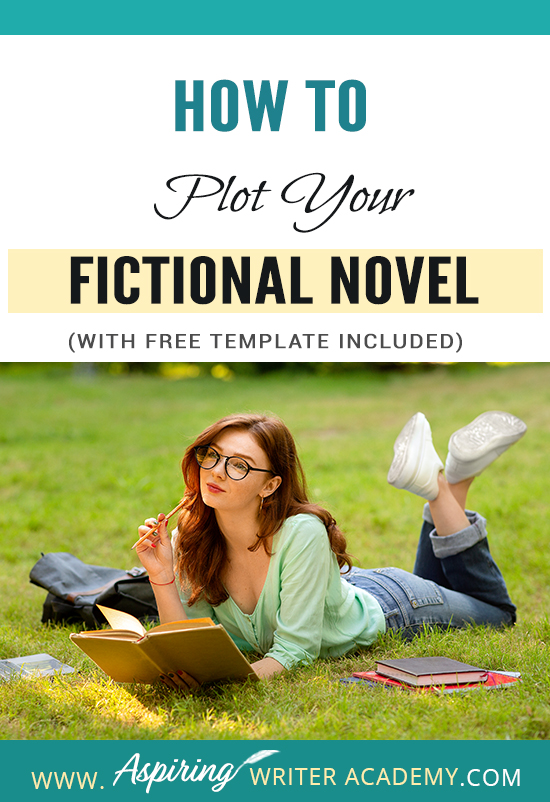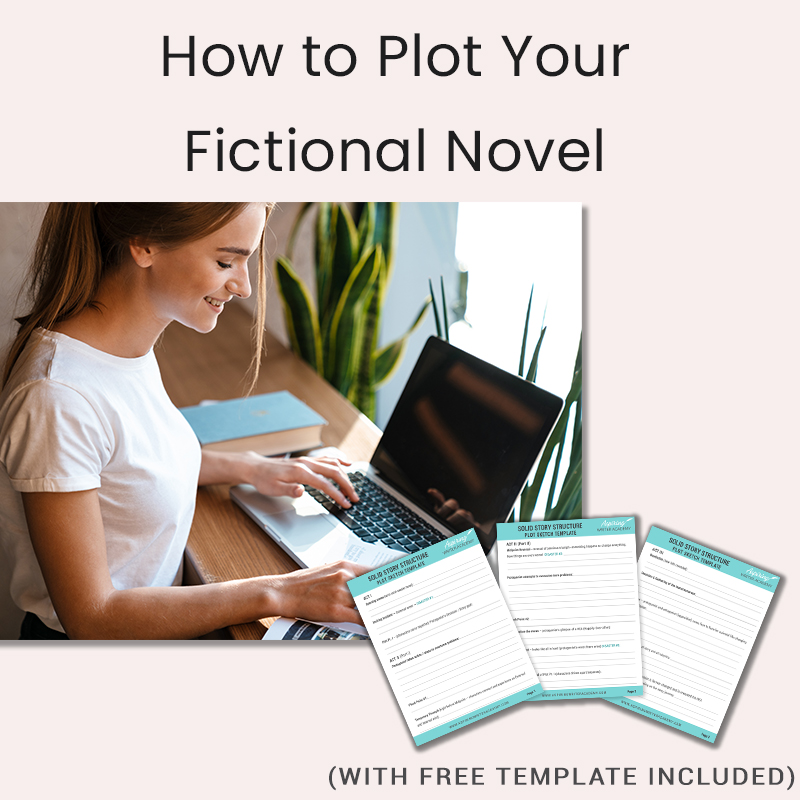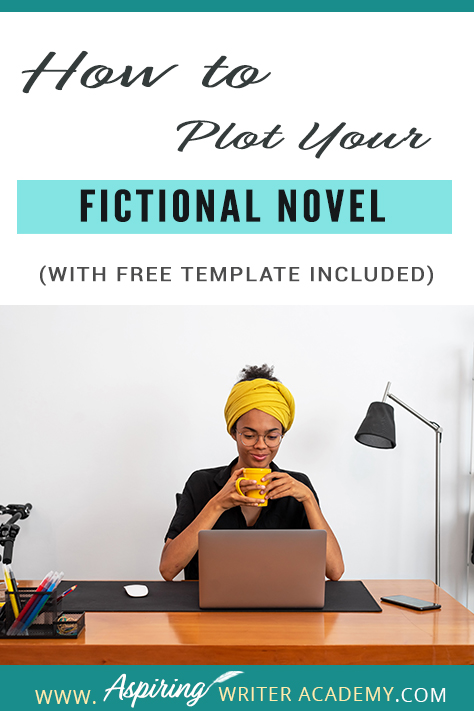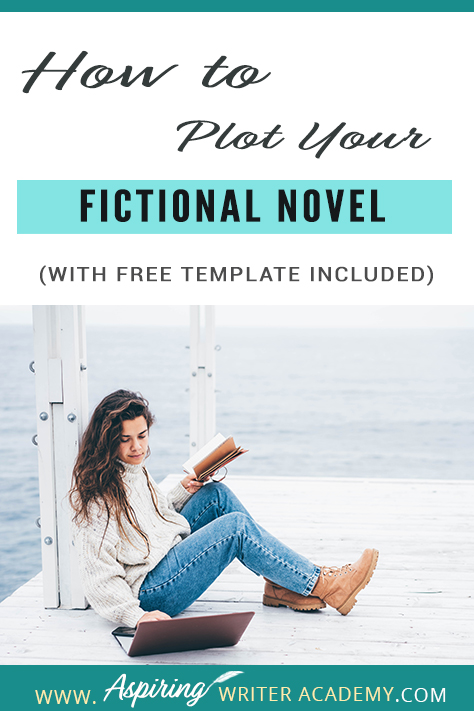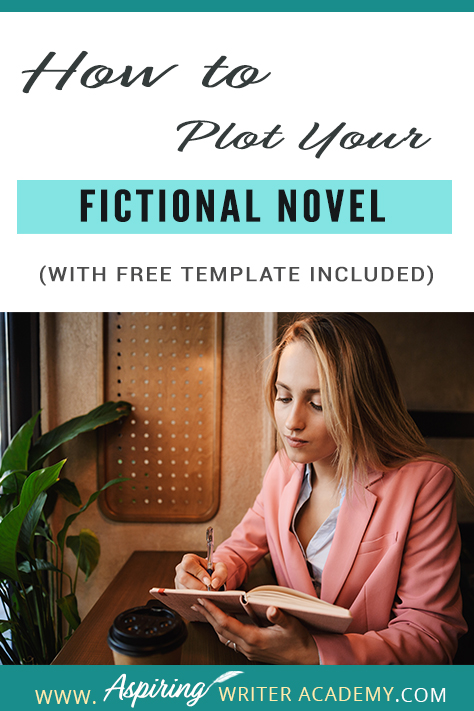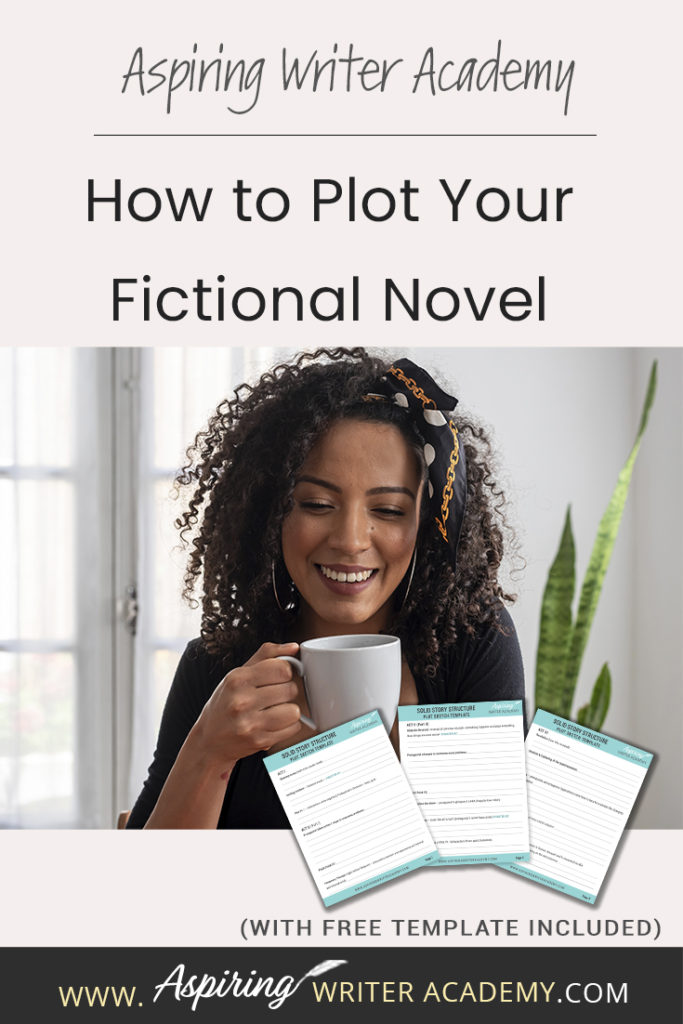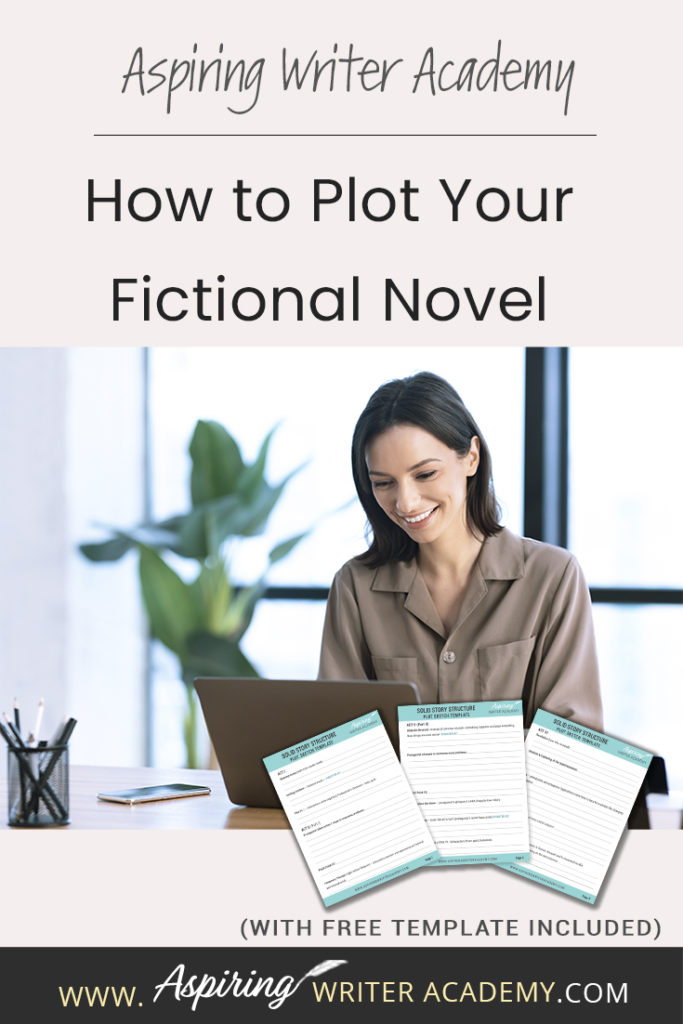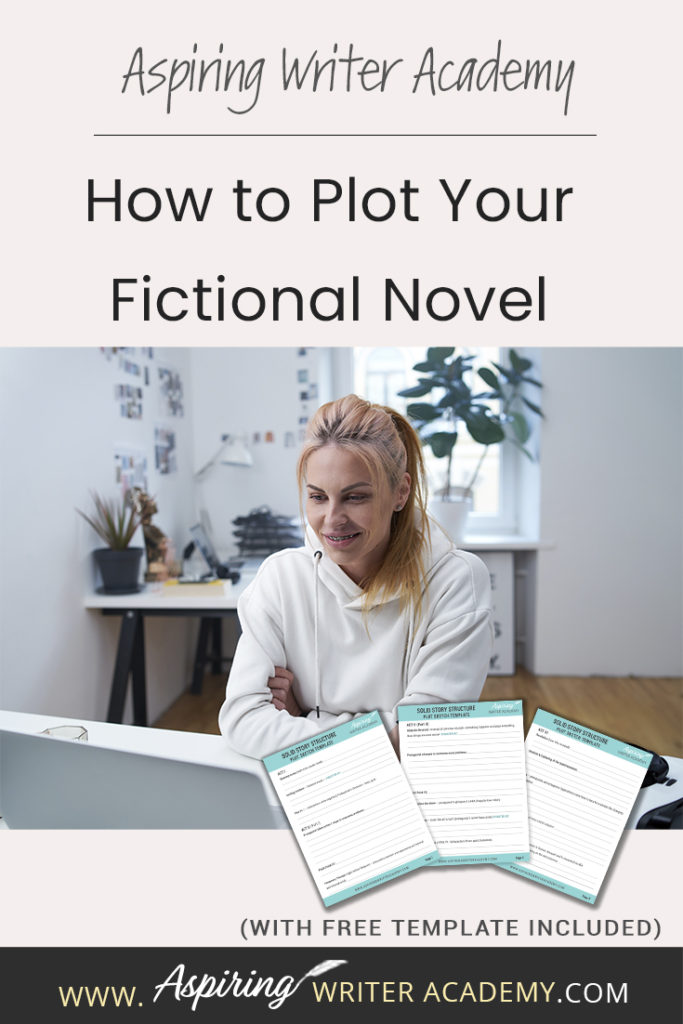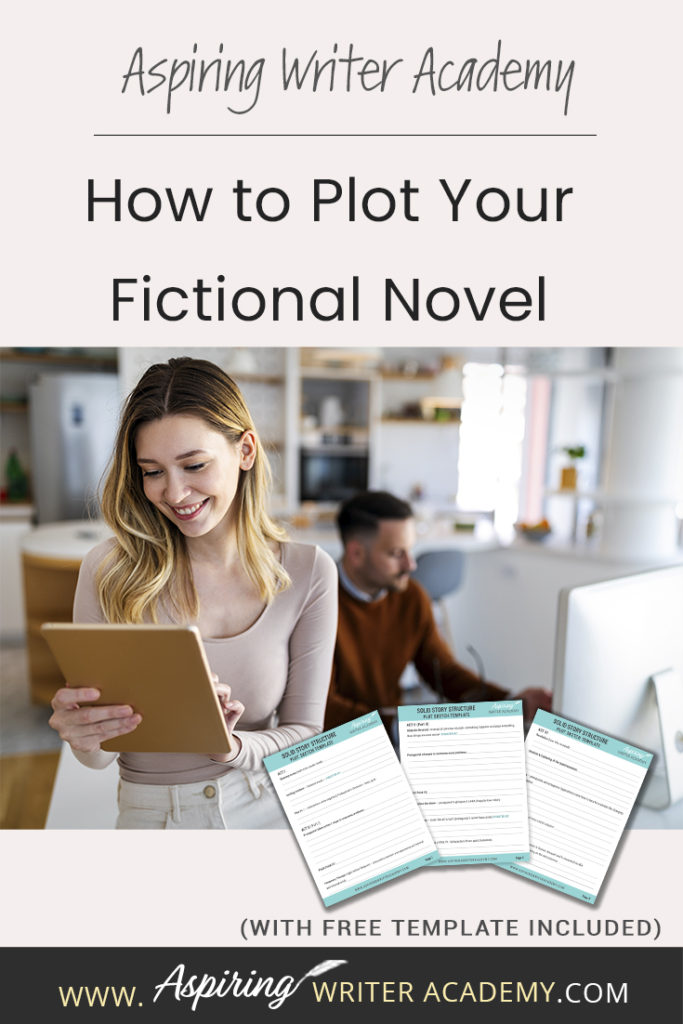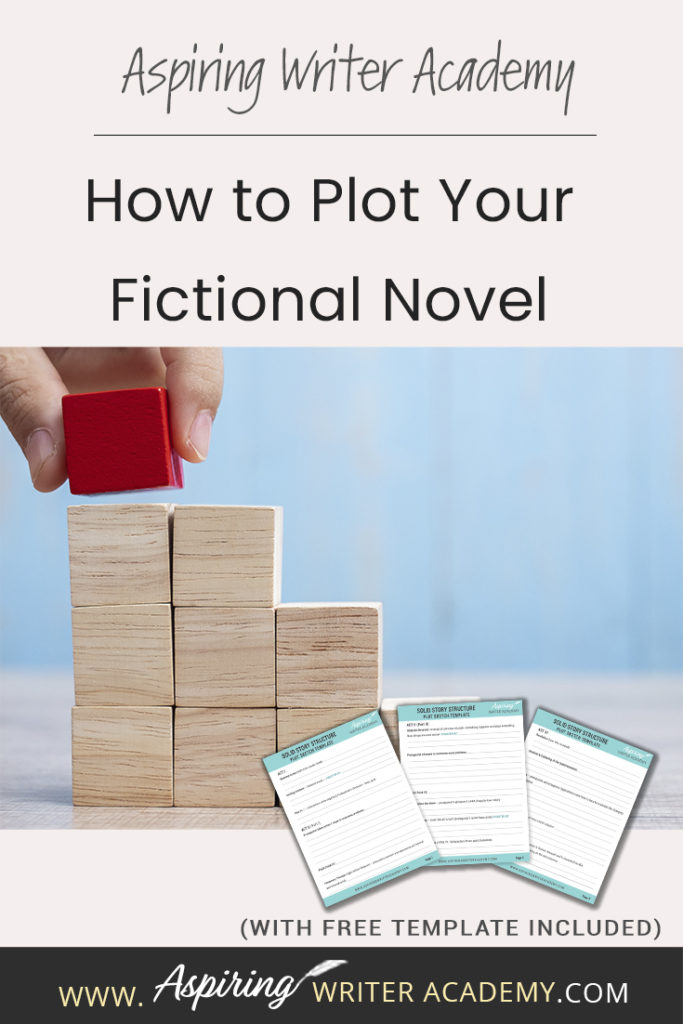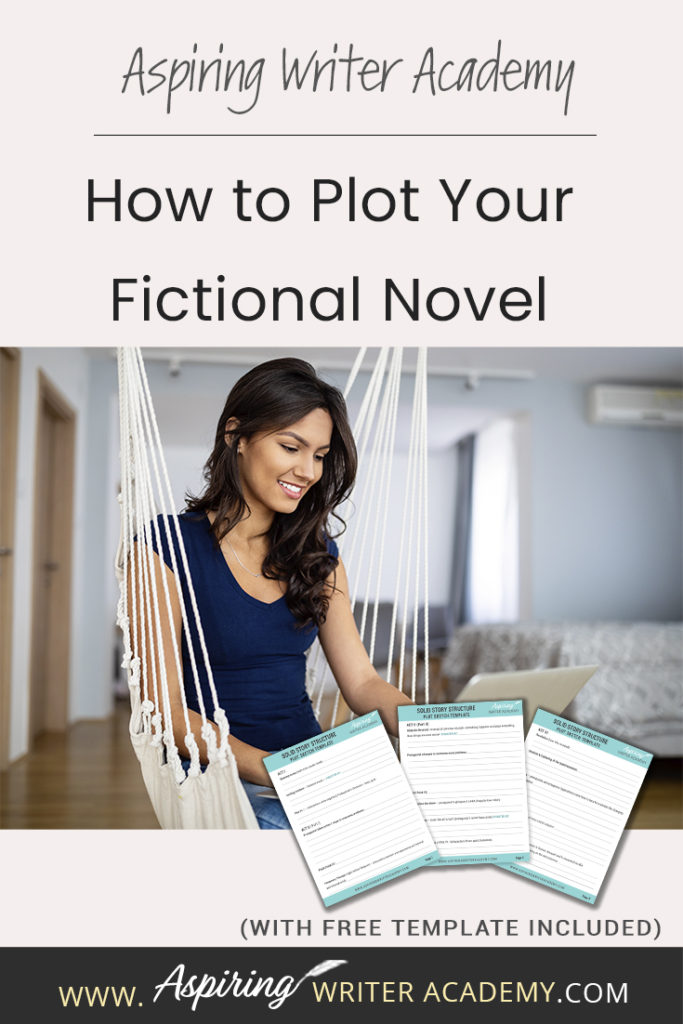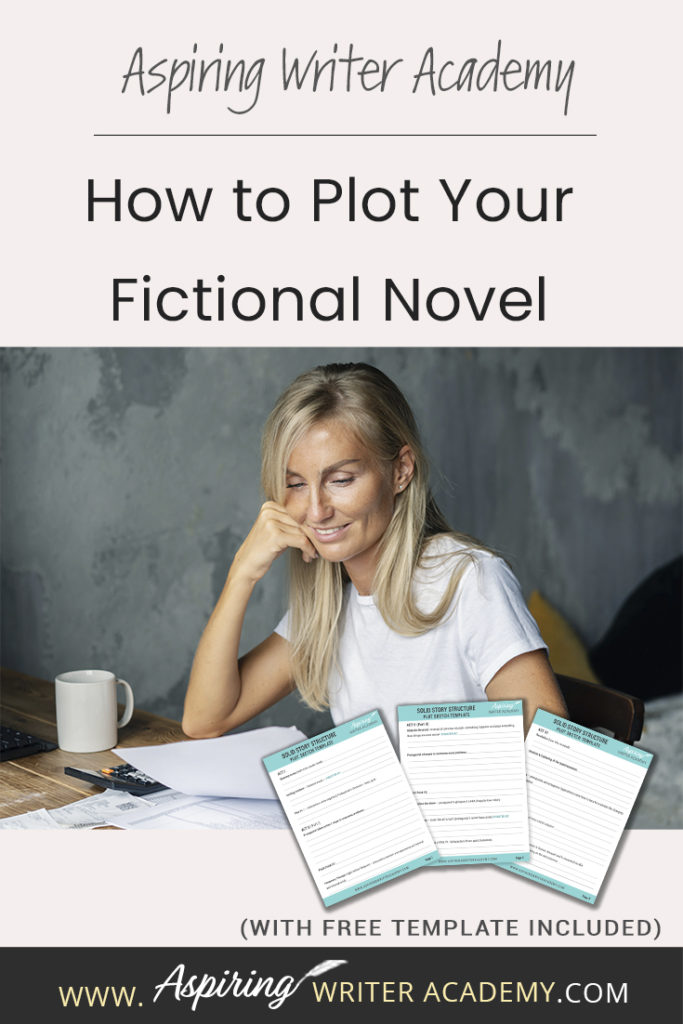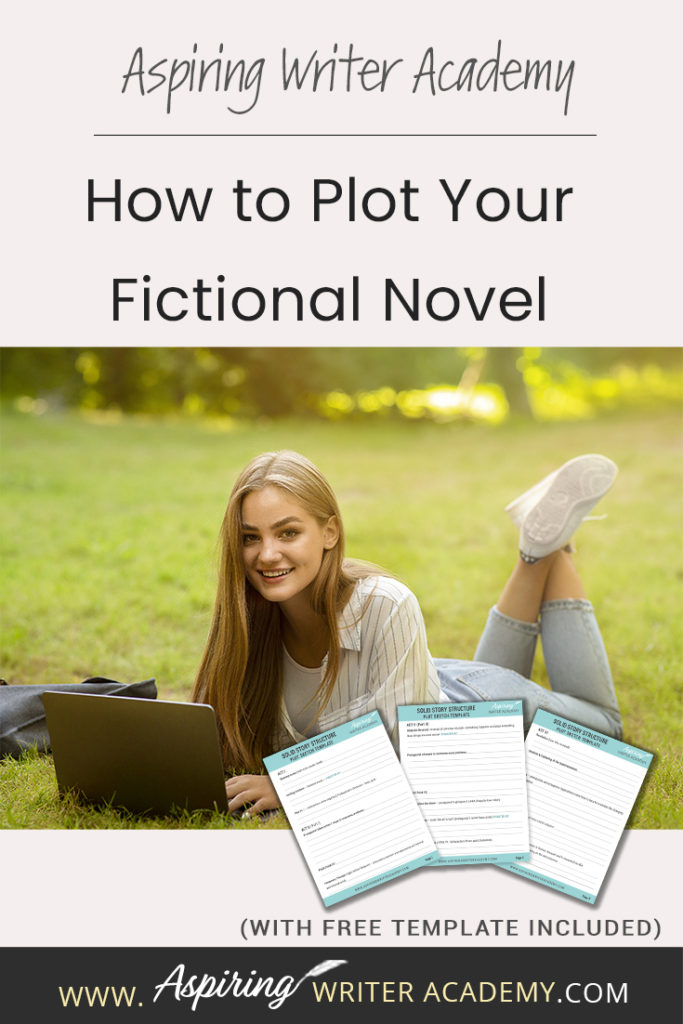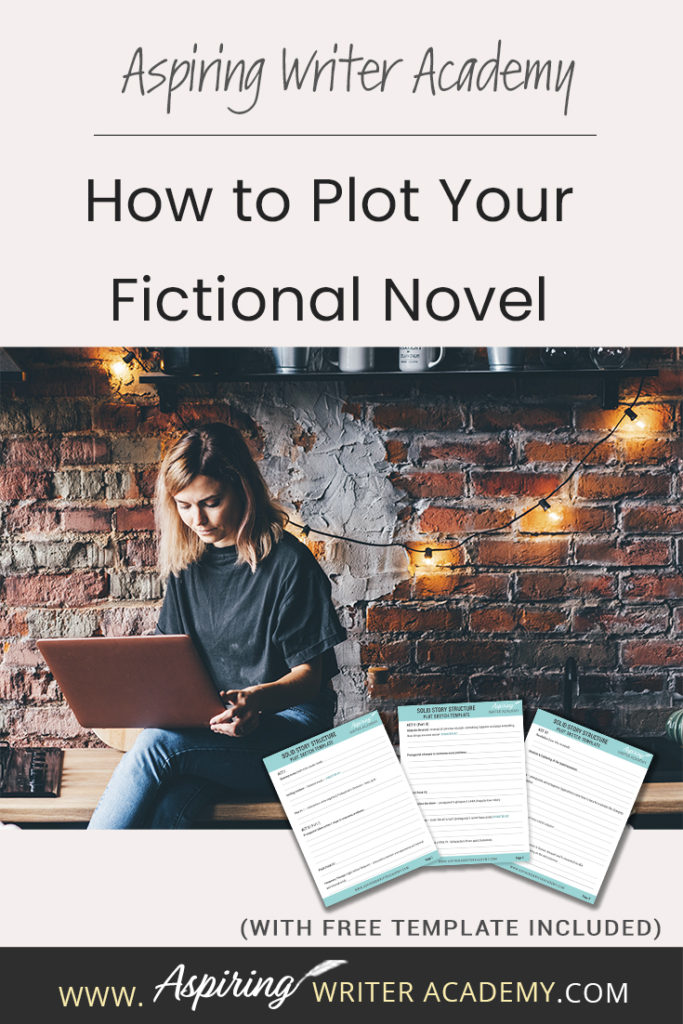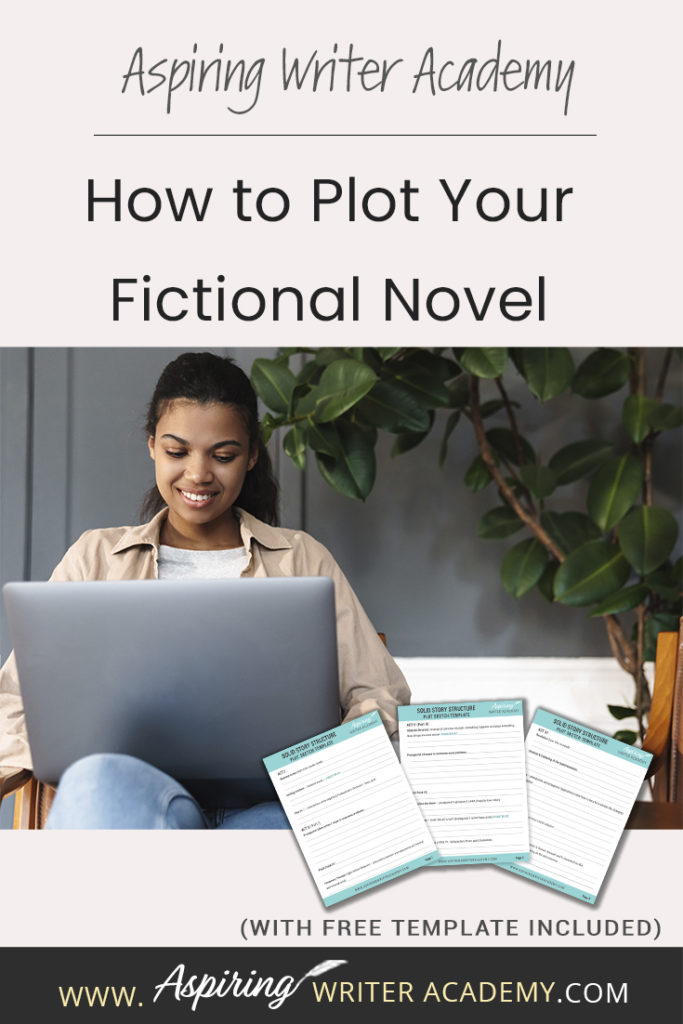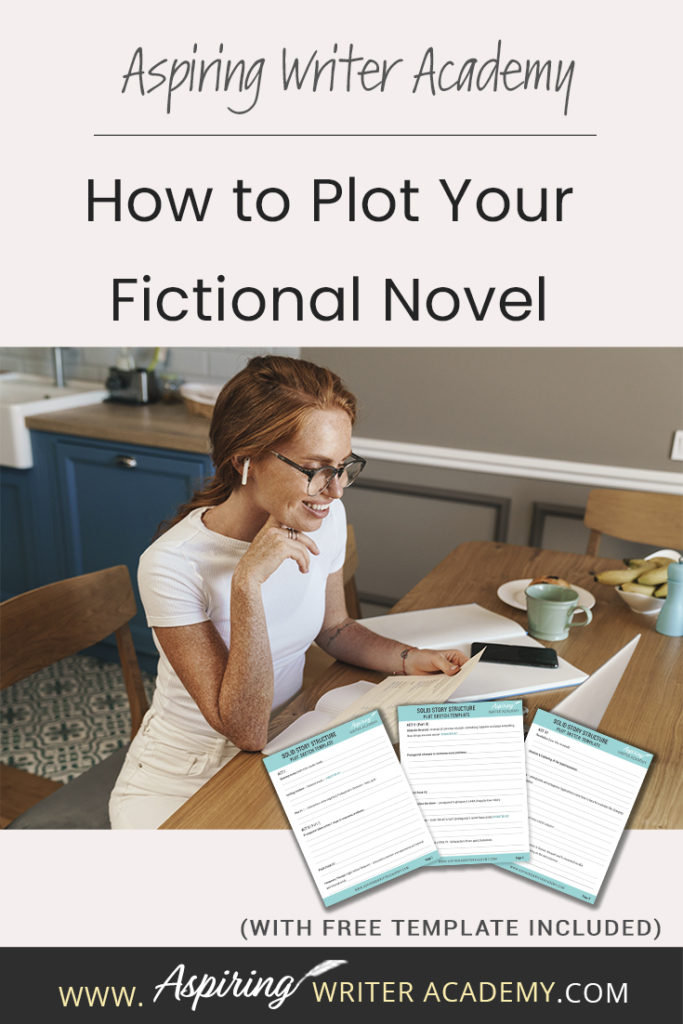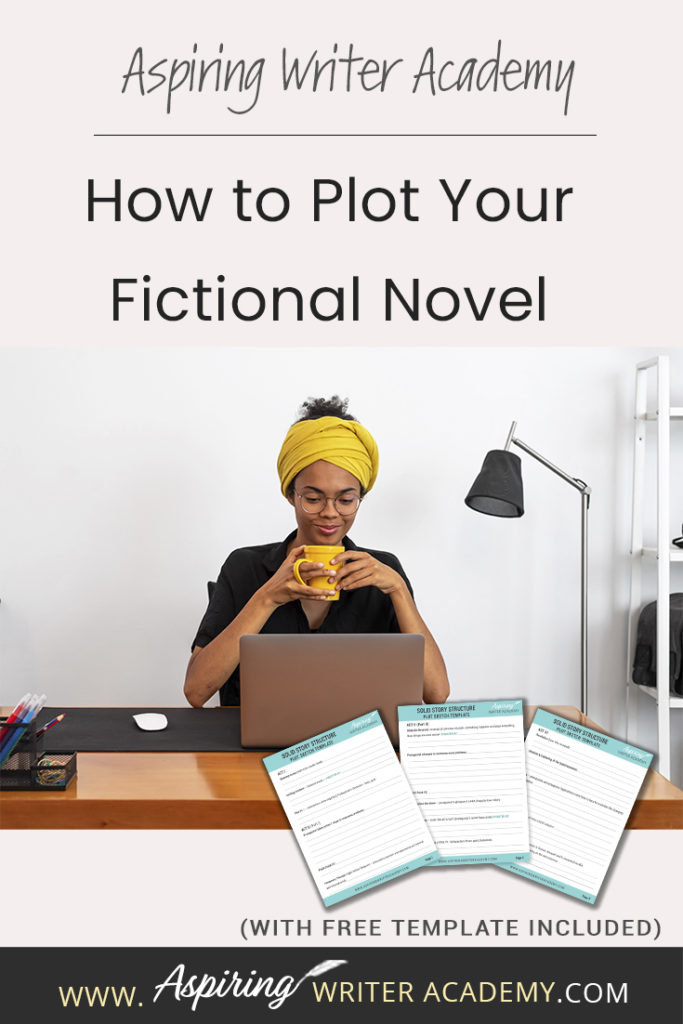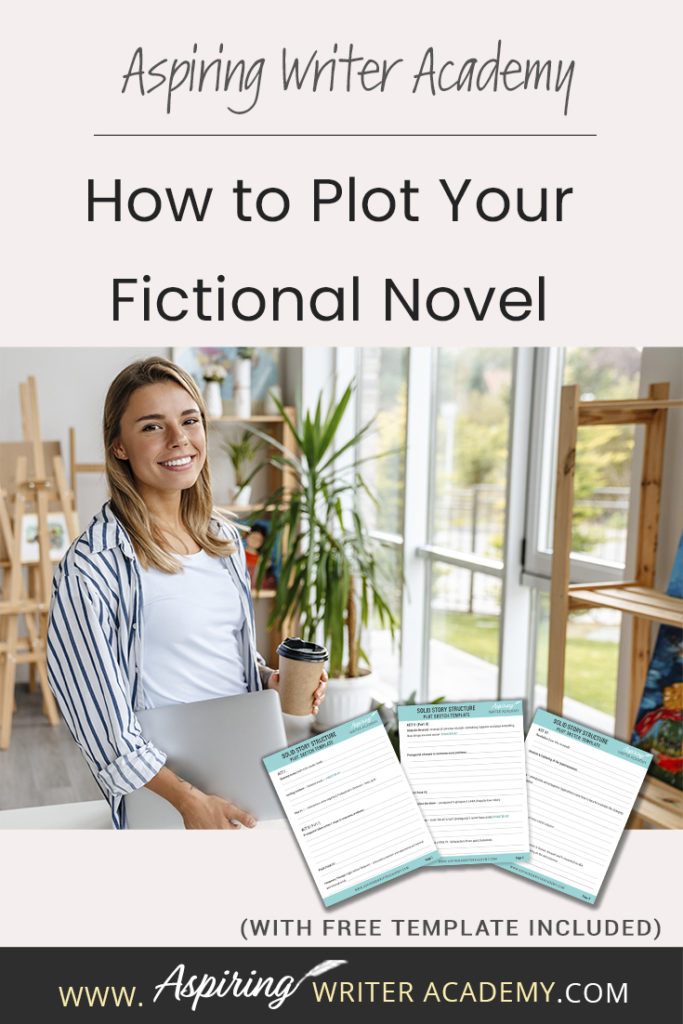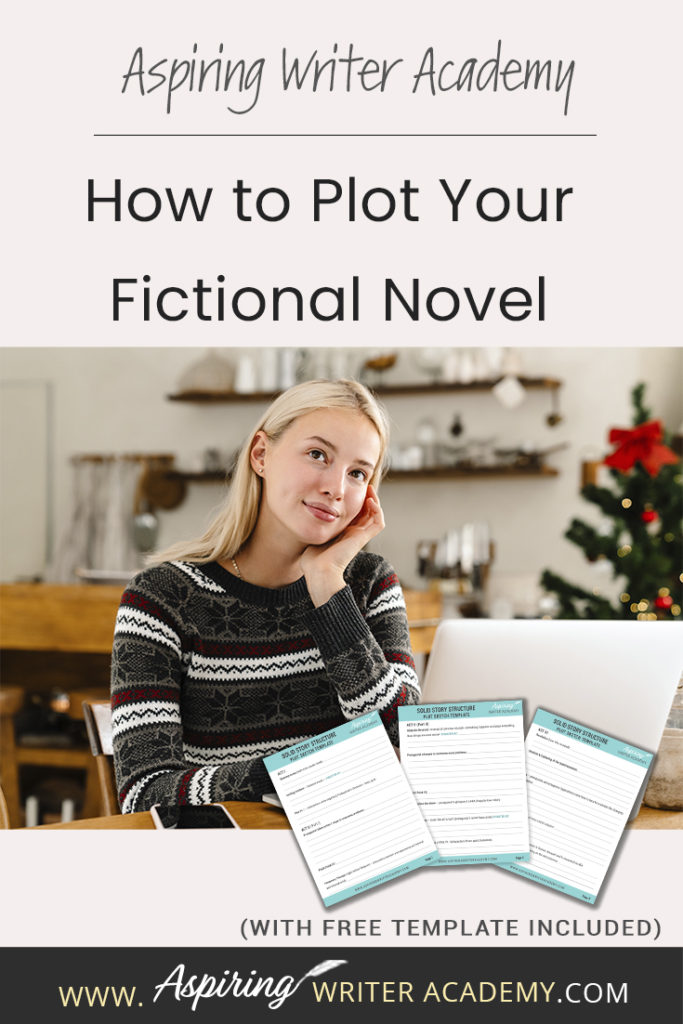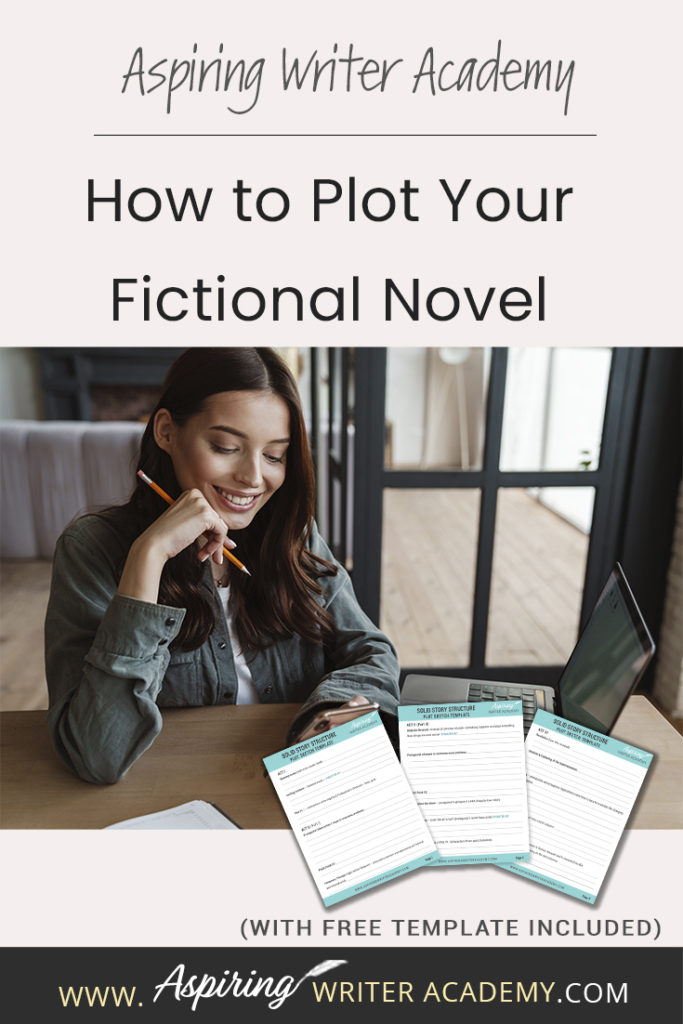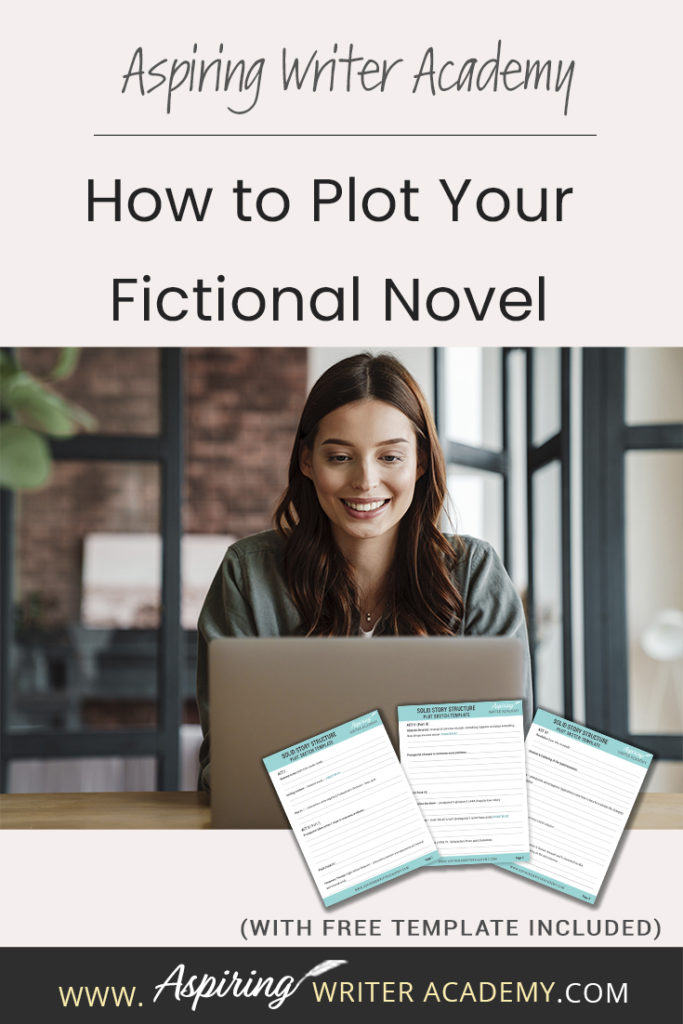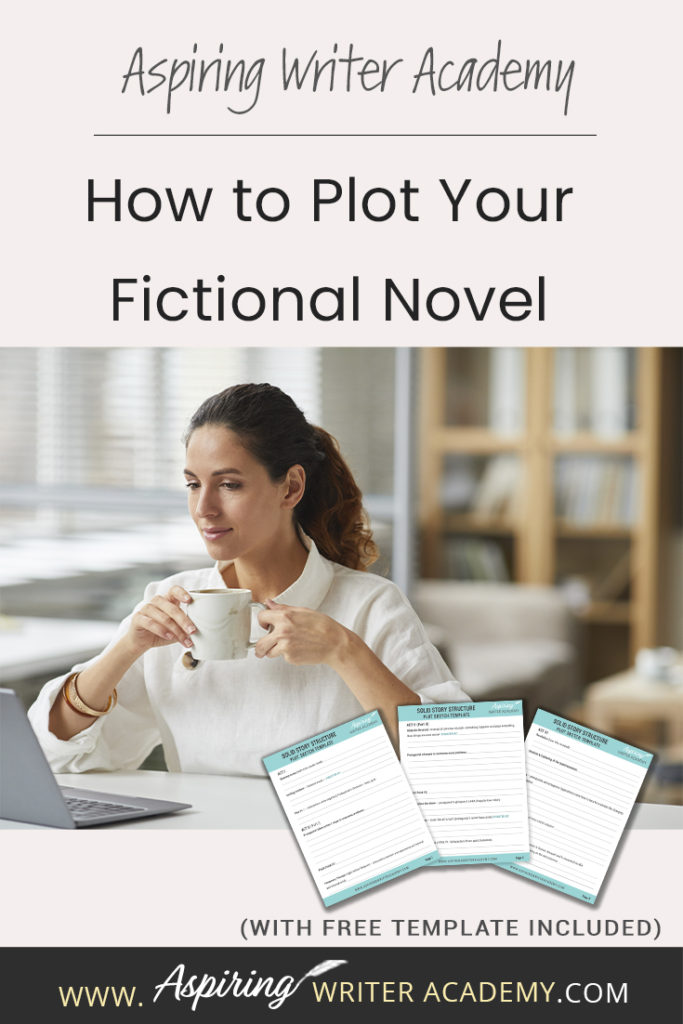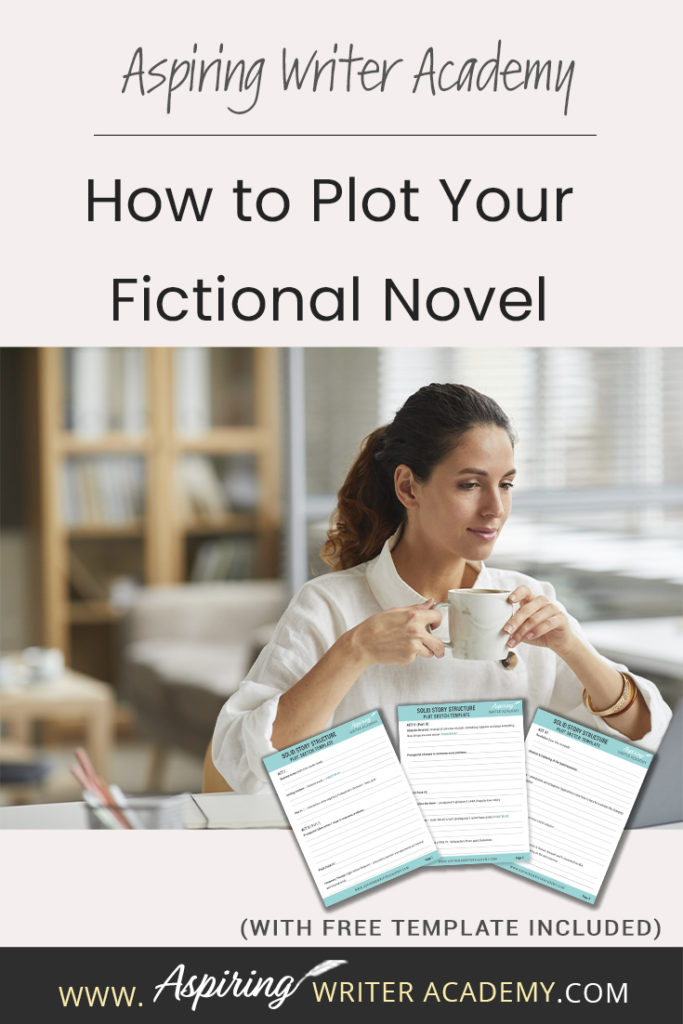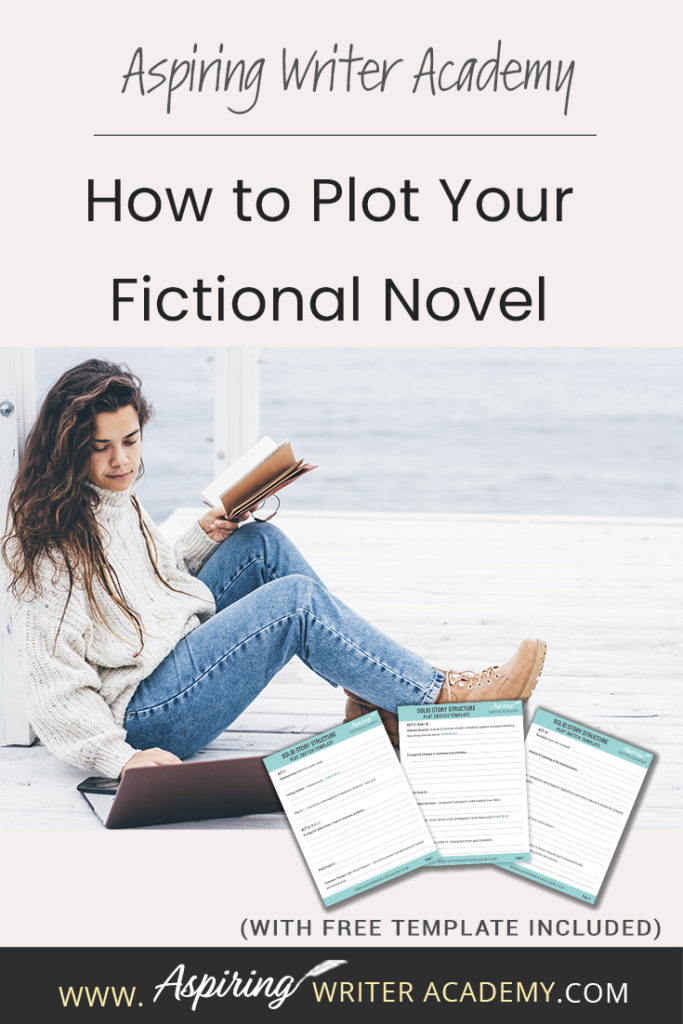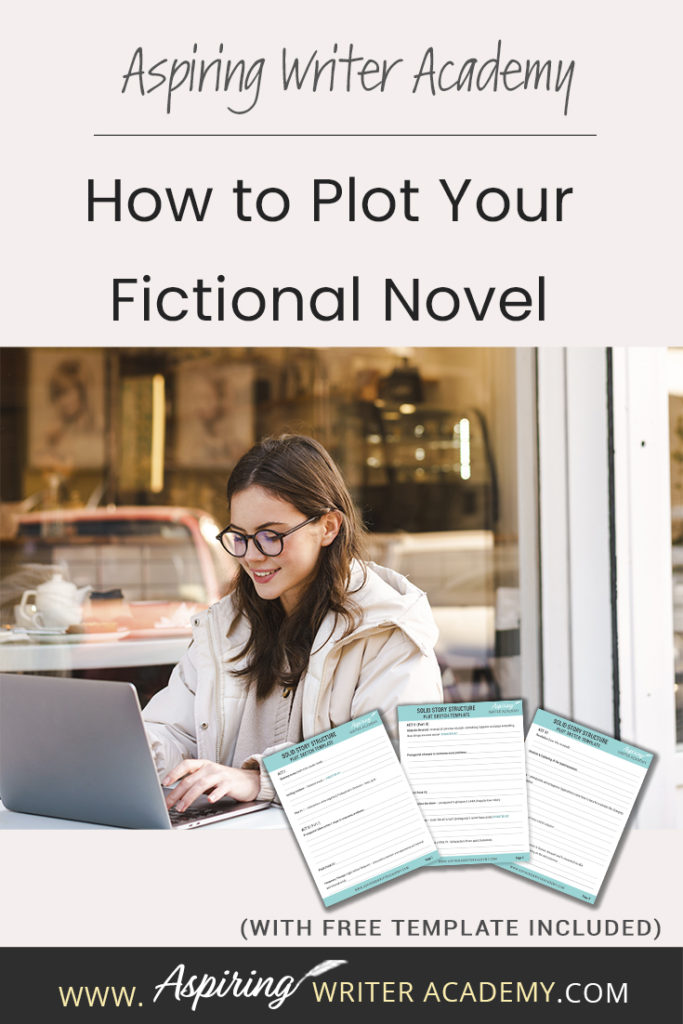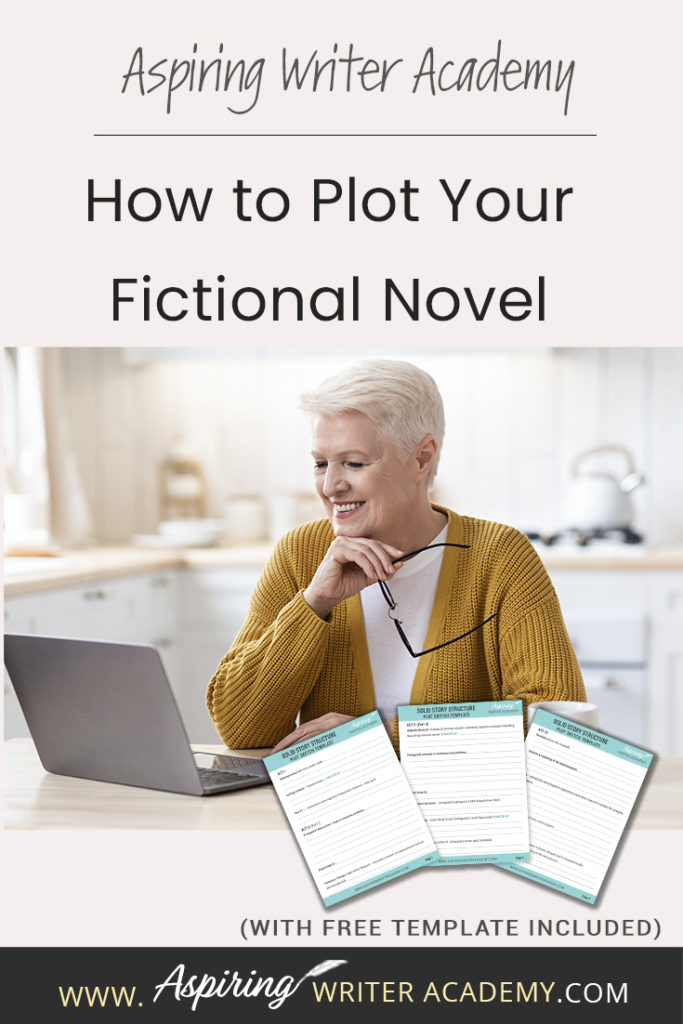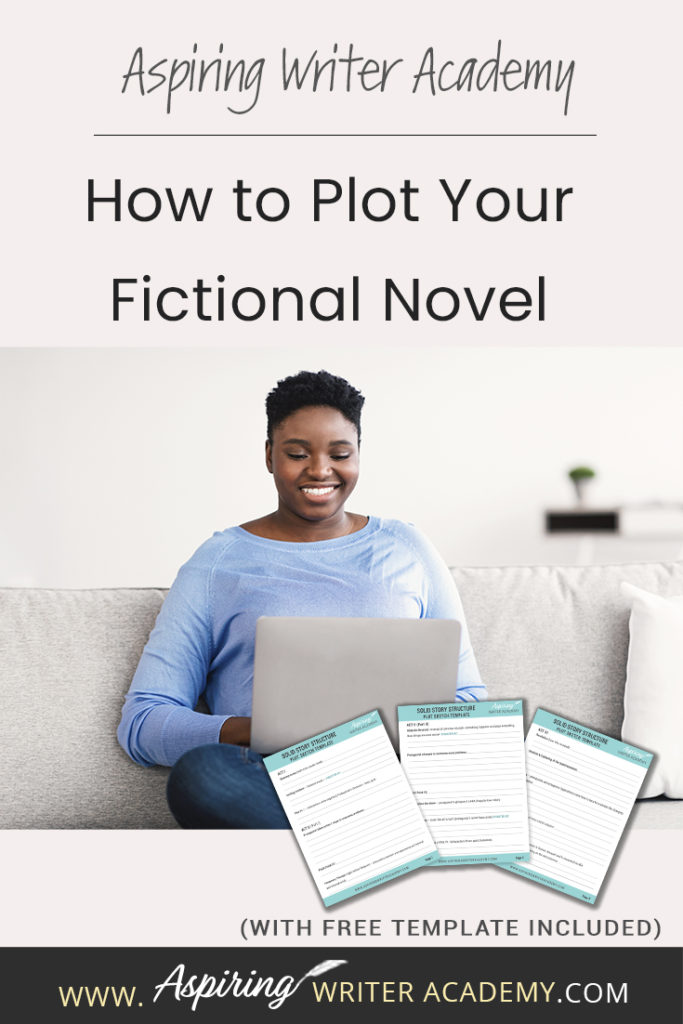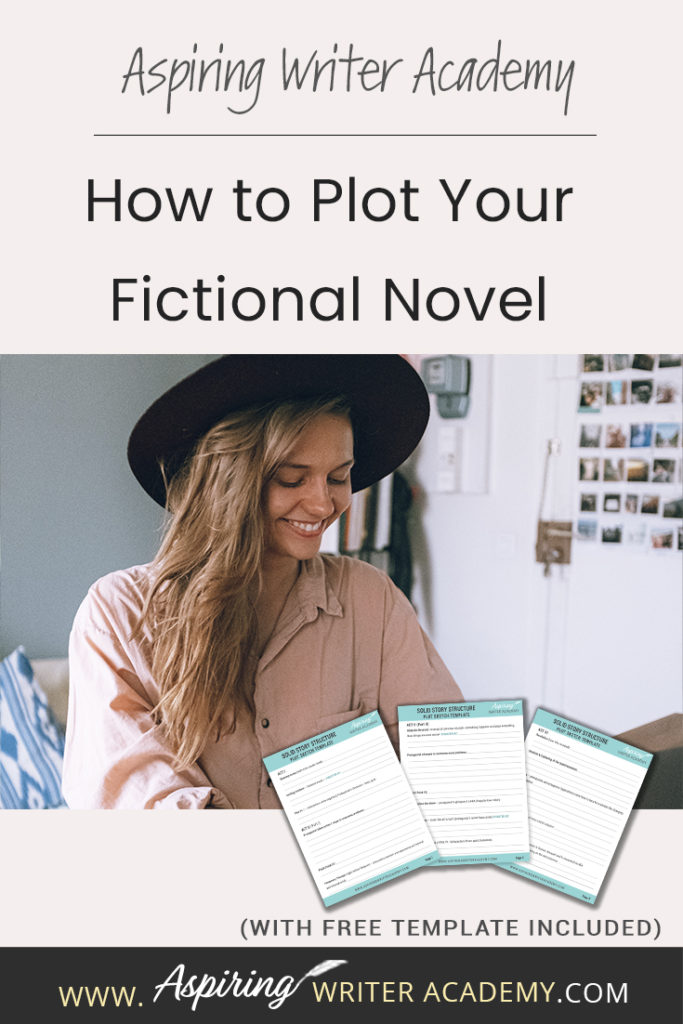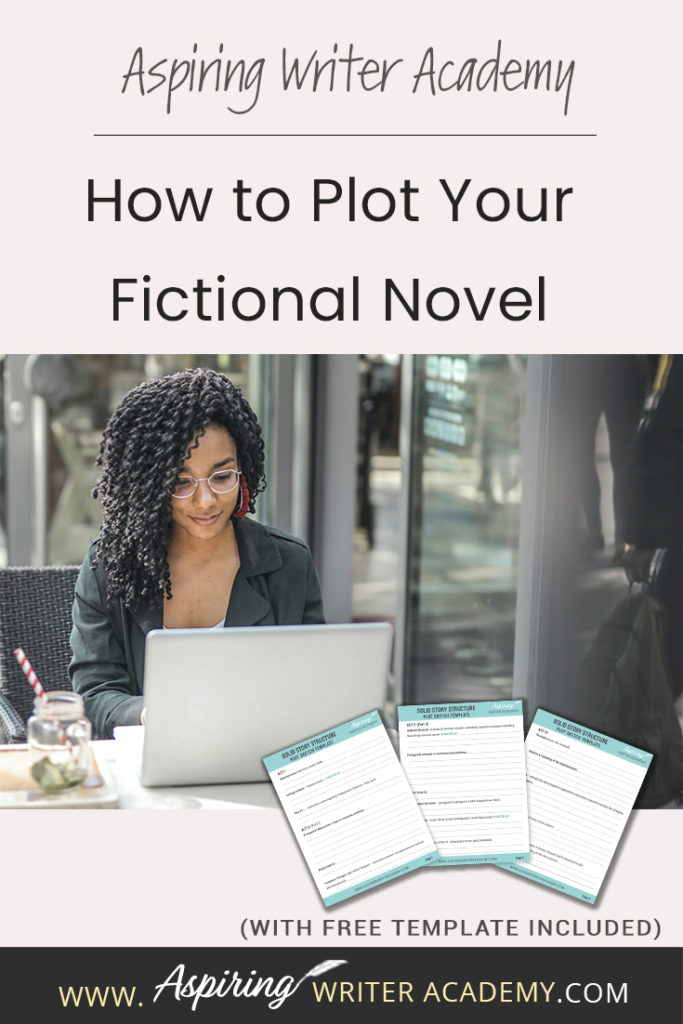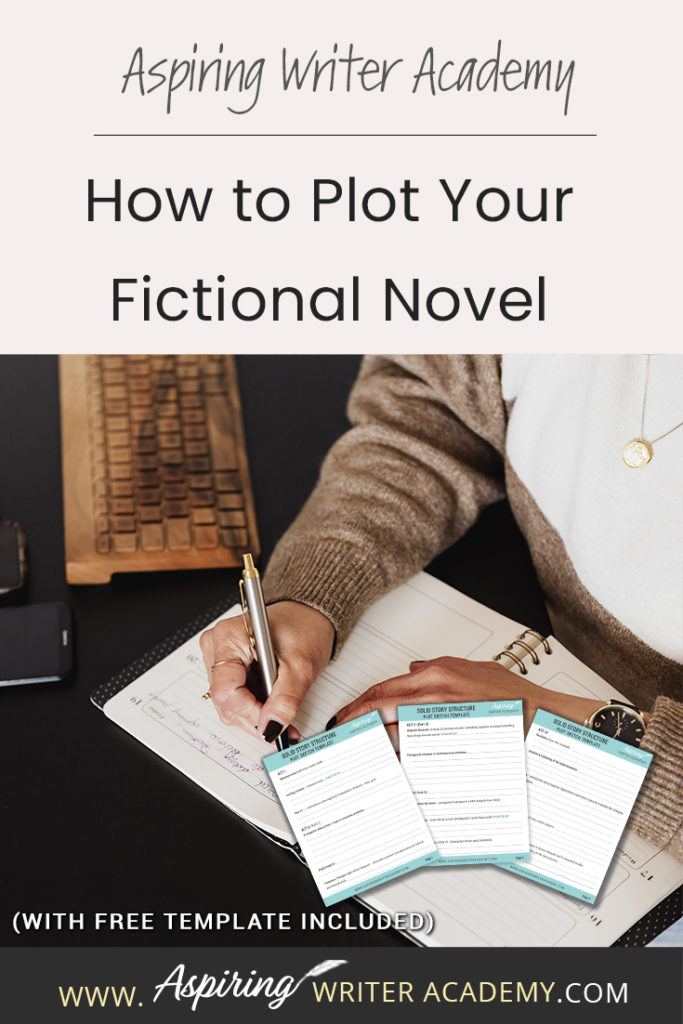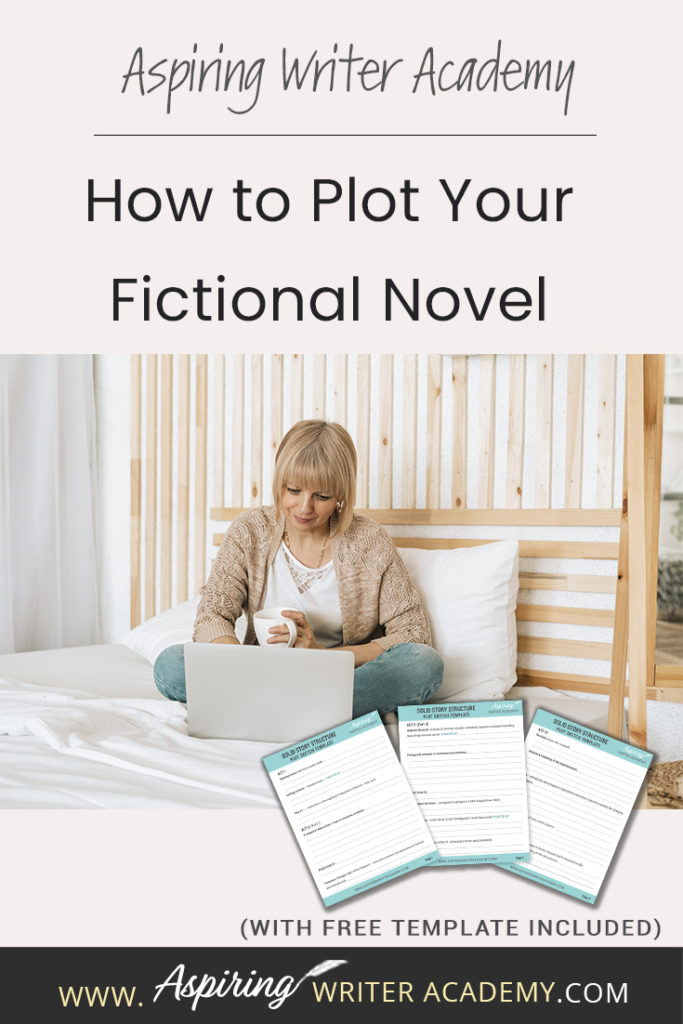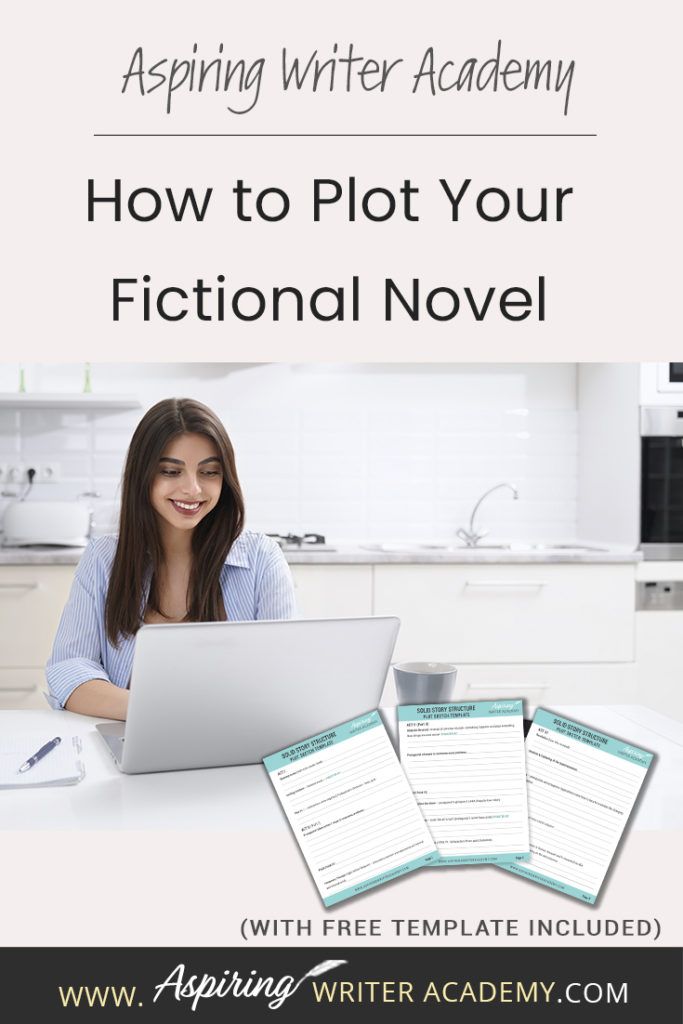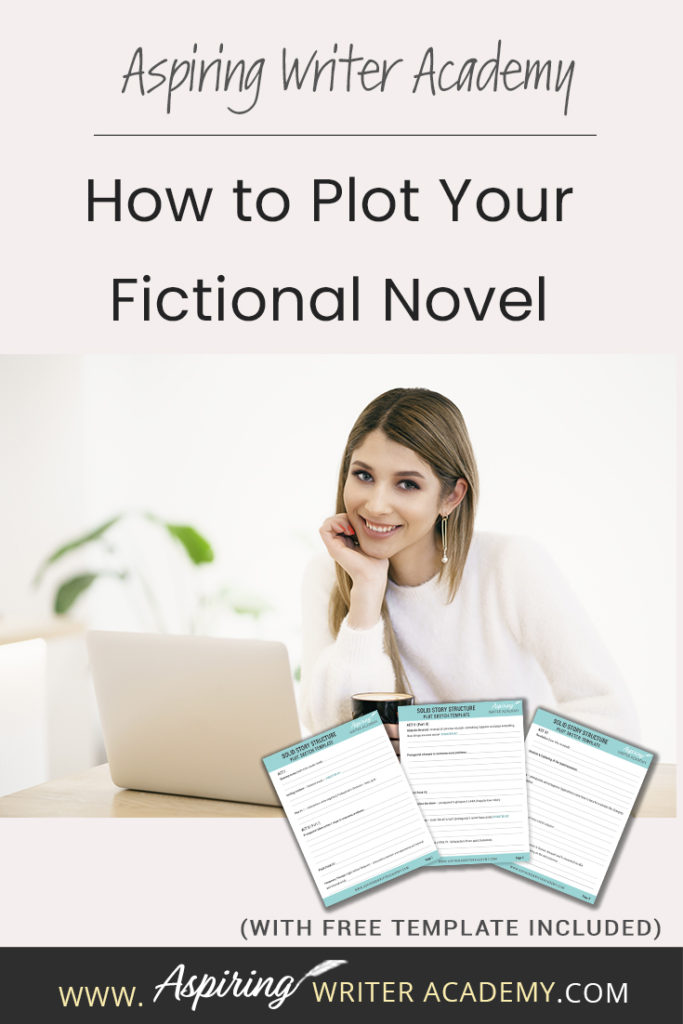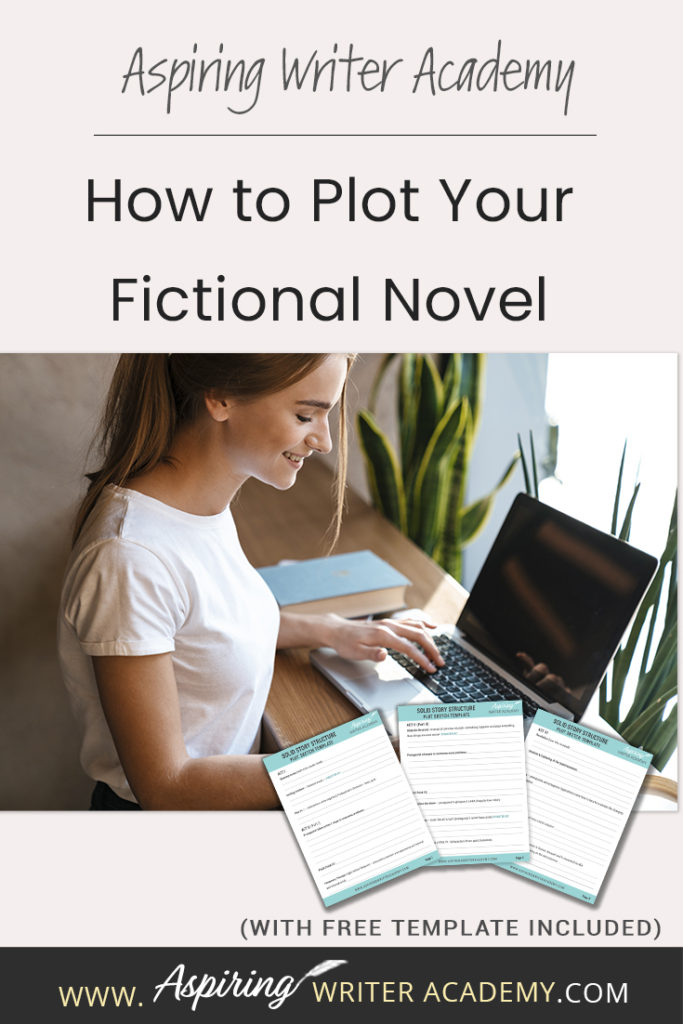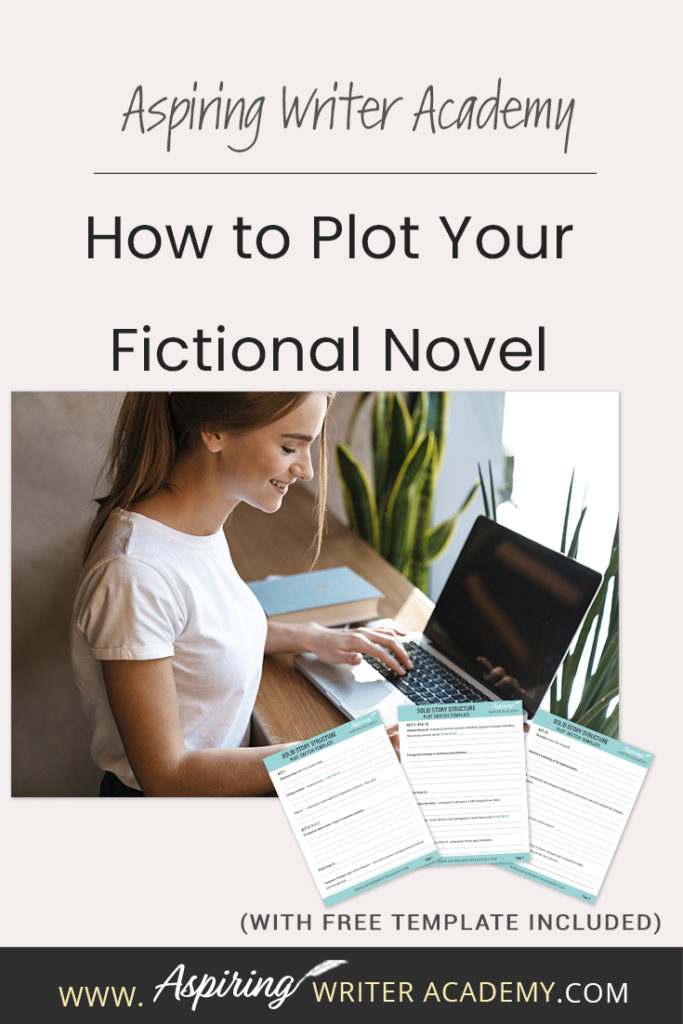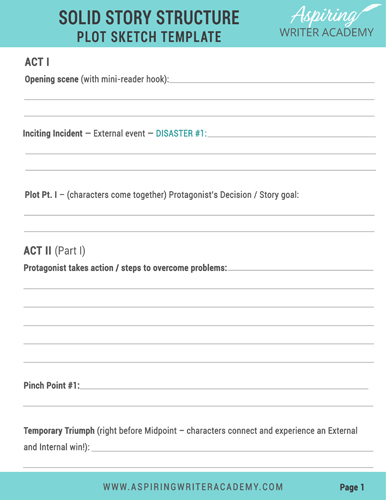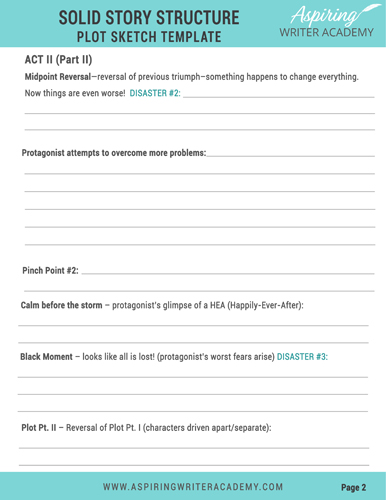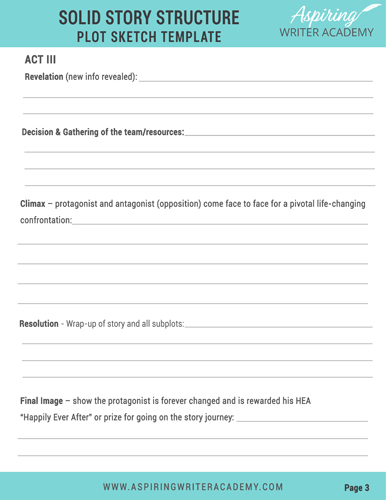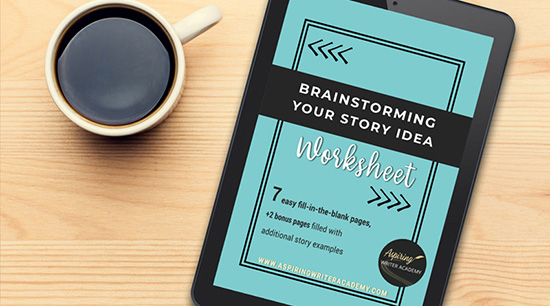How to Plot Your Fictional Novel (with Free Template Included)
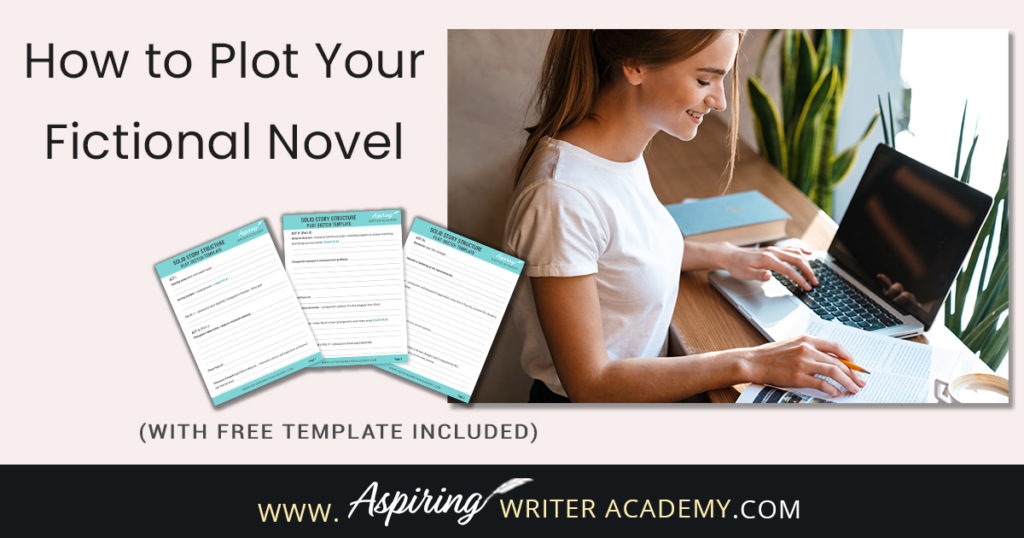
Solid Story Structure. What is it? If you wish to write a satisfying fictional story for your readers, then you must learn the specific elements or ‘Plot Points’ that nearly all Popular Fiction stories share. Using our Free Plot Sketch Template, included in our post, How to Plot Your Fictional Novel, you will be able to identify the various turning points in both movies and books and keep your own stories on track from beginning to end.

When I first began to write, the idea of creating a story where everything comes together to wrap up as it should at the end seemed like a magical mystery to me.
How did authors do it?
I didn’t know that traditional storytelling follows a specific path until I signed up for a few writing courses on plotting. Now I love plotting.
How to create a story from beginning to end still contains a bit of creative ‘magic’ as I am brainstorming how to write each scene (which is good for “Pantsers” (those who like to ‘write by the seat of their pants’) but understanding story structure now helps to ensure that I am headed in the right direction.
The good news is that anyone can learn story structure and use the specific plot elements to create satisfying stories again and again.
Download our Free Solid Story Structure Plot Sketch Template and follow along as we discuss each component in solid story structure below.
The Plot Sketch Template breaks the story down to three Acts. The first Act sets up the story. Act II contains the main action and is broken into Part I and Part II, separated by the Midpoint. The third Act contains the conclusion of the story.
Act I
OPENING SCENES:
The opening sets up the story and delivers the following information:
- Establish the setting, timeline, tone, genre, and general pacing of the story. Where does this story take place? What kind of story is it?
A tense, action-oriented thriller or suspense story may start with a murder, while a lighthearted romance may start with a cute-meet scene of attraction between the romantic couple. Another story may open showing the main character at work to define who he is and what is important to him. Other openings may show the main character in action facing a minor problem.
- Introduce the main character (the protagonist), his/her strengths, and possible weaknesses, and establishes their relationship with others.
As the story opens, it is crucial to hook the reader’s emotions so that they feel connected to the characters and events of the story. Start with an event or situation that piques their interest.
Or have your protagonist demonstrate an admirable quality, skill, or strength to create an immediate bond with the reader. Perhaps they have a unique or passionate viewpoint about a given situation. Give the reader someone likable who they can care about and root for.
Then afterward, perhaps in another scene, also give the reader a hint at this character’s weakness and the lesson this character may need to learn. What is this character not good at?
- Present the protagonist’s short-term goal and long-term goals. What does your character WANT? And WHY? What is his/her PLAN to achieve his goal?
INCITING INCIDENT - (Story Hook, Catalyst, or Disaster #1):
After the characters and the story world have been properly introduced, something unexpected happens that turns your protagonist’s world upside down.
This is typically not the initial problem the character faces in the opening scene but something much more serious. He/she may get a phone call or letter with devastating news, or perhaps there is a murder or an accident.
The inciting incident is the first big attack against the main character by the antagonist, the opposition or villain who will fight against the main character during the course of the story and try to stop him from achieving his goal.
Example: The protagonist could be framed by someone for murder and will need to prove his innocence. Or perhaps the villain comes in the form of a disease, when the main character is told they have cancer and now must fight to survive.
There will be unfavorable consequences if the protagonist does not resolve this problem. It is a matter of life and death for this character, either physically or emotionally. It is the inciting incident which drives the story forward.
In an action-oriented story, or story involving a quest, this could also be the call to adventure, the opportunity to leave the ordinary world behind and do something new. Example: An invitation (or command) to travel to an exotic location, journey into space, board the pirate ship on a quest for gold, join the wagon train on the Oregon Trail. Or perhaps accept the offer of a new job.
However, this Inciting Incident should introduce serious conflict for the protagonist. The journey ahead will not be easy. And there must be a compelling reason why the character must act.
Example: In the movie, Romancing the Stone (1984), a reclusive novelist receives a ransom note demanding that she travel to Columbia to trade a treasure map for her kidnapped sister. The consequences: If she does not act, her sister will die.
Watch Romancing the Stone on Amazon: https://amzn.to/3BPEKob
PLOT POINT I:
Answering the call. The character makes a decision on how to handle the problem he/she was just presented with during the inciting incident. At first the character may decline the offer or refuse to act. However, after considering the stakes, the compelling serious consequences, the character finds he must accept the call to adventure that takes him on the story journey. Even if it takes them out of their comfort zone.
Plot Point I is usually the very last scene of Act I. It is the actual decision to take action against the problem that will carry them through the rest of the book. It may be the specific agreement between two characters.
In a romance, the hero and heroine are forced/or agree to work together or go on the quest together to defeat a common enemy or overcome a mutual problem. Or if they start out as enemies, it may be the vow to fight against each other over a specific issue with a deadline (before they start to fall in love). Example: Two people each determined to run for mayor.
Plot Pt. I is the point where your main characters come together.
Example: Two cops, played by actors Mel Gibson and Danny Glover, become partners in the movie Lethal Weapon despite their differences.
Example: In the movie, The Lord of The Rings: The Fellowship of the Ring, the hobbits, elves, men, and dwarves come together and form a group to travel to Mount Doom to destroy ‘the One Ring’ of power and defeat great evil.
Watch Lethal Weapon on Amazon: https://amzn.to/3HcK2Lt
Watch Lord of the Rings: The Fellowship of the Ring on Amazon: https://amzn.to/3HaSuuU
ACT II (Part I)
- The protagonist creates an ACTION PLAN, specific steps he/she intends to achieve to overcome the problem caused by the inciting incident. What is the first step the protagonist decides to do?
- During the first half of Act II the protagonist (and his allies) will have their strengths and their weaknesses tested. Problems will arise as they take their first steps to overcome the story-worthy problem caused by the inciting incident. Will their attempts be blocked where they need to try a new approach? Will a complication make their current situation worse? Will a new problem cause them to take a detour?
- Each challenge your character faces as they struggle through ACT II should be harder than the previous one. The antagonist does not sit idle but continues to throw the main character additional blows. The antagonist does not want the protagonist to succeed.
- During the first half of ACT II, your protagonist may have a mentor who teaches him, or helps show him the way. What new skills will the protagonist have to learn? What bad habits will he have to overcome?
- Each scene should have a goal, motivation, and conflict. What is the purpose of the scene? What does the character hope to achieve? Why? Who will try to block the character’s progress in this scene, prevent him from achieving the scene goal?
PINCHPOINT #1:
- Part way through the first half of ACT I the protagonist may see or hear something that causes him to react emotionally – called a ‘Pinch Point.’ The event pinches his emotions and reminds him why his goals and this journey is important to him. It serves to renew his motivation to keep going when the going gets tough.
- Each scene gives the character insight or mini epiphanies leading him toward character change and the ultimate climax where everything is put on the line and must be resolved. This incremental change in character is called a ‘character arc.’ The protagonist will grow as a person, become better or wiser in some way. He may be able to do something at the end of the book that he could not do at the beginning.
- Each scene ends with the character making a CHOICE. What will he/she do next?
- Each choice the character makes should reflect your story’s theme, the message you want to subtly convey to the reader, the lesson your main character needs to learn.
TEMPORARY TRIUMPH (right before Midpoint):
- At this point in the story, some pertinent backstory is finally revealed, an understanding occurs between characters, and there may be a breakthrough where the character receives some good news or wins a battle, or something happens to make the protagonist believe he is about to achieve his goal. It looks like he is going to win, overcome the problem presented during the inciting incident, defeat the opposition!
- This is where the characters may finally come to understand each other in a way they hadn’t before. In a mystery, insight into a specific character may provide info or shed light on a piece of the puzzle surrounding a complicated case. In a romance, this is where the characters may share a tender moment and kiss!
MIDPOINT REVERSAL AND ACT II (Part II)
MIDPOINT - reversal of previous triumph, turns the story in a different direction, Disaster #2.
- Something significant happens at the midpoint that changes everything and turns the story in a different direction. Perhaps the information the protagonist received at the temporary triumph was set up by the antagonist, a lie, a false triumph. Now everything is worse. Perhaps the protagonist’s mentor dies, leaving him to go forward into the 2nd half of ACT II on his own. Perhaps the protagonist discovers his friend or lover has been keeping a big secret.
- Often there is a mini sequence of scenes or a 3-part event over the midpoint section to slingshot the pacing and the storyline over into the second half of ACT II. A mini-story with its own beginning, middle, and end. Perhaps the main character goes out of town to visit a friend, or check on a lead, or find a clue. This also helps avoid “saggy middles” (where your story may slow down and become dull).
- After the midpoint, the protagonist will start to do things differently. While he/she may have been more reactive in the first half of ACT II, now he/she will now be more proactive and take charge. The protagonist will try to overcome new problems.
- PINCHPOINT #2 - The protagonist may once again see or hear something that causes him another emotional pinch that reminds him what is at stake and why he must persevere and continue on despite the odds and his own doubt.
Example: In Hunger Games, by Suzanne Collins, the protagonist (Katniss Everdeen) sees her young friend, Rue, die. The child’s death is heartbreaking and reminds the heroine what could have happened to her younger sister if Katniss hadn’t taken her sister’s place. The heroine digs deep, and filled with emotion, finds new resolve. This is shown when she holds up her hand with a defiant signal to the camera letting the villains and everyone else watching know that she will not quit.
Watch The Hunger Games on Amazon: https://amzn.to/3scgYQc
CALM BEFORE THE STORM:
Similar to the temporary triumph, the protagonist may receive another piece of good news or obtain a small external win to boost his moral. In a relationship story, this is where everything seems almost peaceful for a moment, and the protagonist is hopeful everything will work out. Achievement of the story-worthy goal seems within reach. Perhaps the protagonist discovers the antagonist’s weakness and knows how he can use it to his advantage.
BLACK MOMENT – Disaster #3.
Just as quick as the turn-around at the Midpoint Reversal, the black moment slams the protagonist with another blow he did not expect. The protagonist may be confronted with his worst fear and think he’s failed, that all is lost. The main character may think he has been betrayed by another whom he had trusted. (This would be the significant other in a romance, buddy relationship, or the people within their group.) For a moment, the protagonist may revert back to old behaviors and forget all that he’s learned. The black moment is one of misery and despair.
PLOT POINT II - Reversal of Plot Pt. I (the characters are driven apart)
Due to the situation that unfolded at the black moment, the protagonist is separated from others. This could be due to his own feelings or external events he cannot control.
If the protagonist felt betrayed at the black moment, his past may resurface to remind him he should have never trusted others, and he may decide to go it alone from this point on.
In the movie, Romancing the Stone (1984), the heroine finds she is on one side of the raging river with the map and the hero is on the other side of the river with the jewel. They will have to decide to go it alone for now and meet up again later in a different place.
Act III
REVELATION (new info is revealed)
The protagonist may receive key information that makes him realize that he was not betrayed after all. Or he may be told a secret that finally allows him to defeat the antagonist, a new opportunity to succeed that he did not see before. Perhaps the protagonist realizes it was his own flaws that caused him to react the way he did, which propelled the black moment. He may realize that it was he who was at fault.
DECISION & GATHERING OF THE TEAM/RESOURCES
- With the new information the protagonist received with the revelation, he regathers his strength determined to try one last time to defeat the villain/antagonist and overcome the problem he was presented with at the inciting incident.
- The protagonist may need to re-gather his team or get the supplies he will need to go into the climax of the story where he will face the antagonist or main story problem head on.
CLIMAX
The hero comes face to face with the villain/antagonist and valiantly strives to overcome his own fears and flaws to win the battle. Look to the character’s strengths and weaknesses to discover what leads to the villain’s downfall and the protagonist’s success. This should be the most intense scene of the entire story.
What can the protagonist now do that he couldn’t at the beginning of the story? Does he have to sacrifice something to succeed? What did he learn from going on the story journey? Everything is put on the line. The problem is either resolved and the goal is accomplished, or it isn’t.
Nothing gets dropped out of the sky. If the character uses a talent, has a weakness, or uses a weapon at the end, be sure to foreshadow this by introducing it into the story 3x’s prior!
RESOLUTION
The protagonist has overcome his story-worthy problem and reflects on the events of the story. How has this journey affected him? How will you show the protagonist is now changed for the better? How will other characters react to the protagonist’s change? Did the protagonist have to sacrifice something? What will he do now?
FINAL IMAGE OF THE STORY
The last scene of the story should be memorable. To show that the main character’s story journey was meaningful, show him in action doing something that proves he has learned from his experience and has changed.
In a romance, the romantic couple has resolved their issues and they commit to one another in a scene that promises they will live ‘Happily-Ever-After.’ The tangible proof of their commitment may be the presentation and acceptance of a ring (a solid symbol). This may be applied to other stories as well. What tangible item can you insert into the story to represent the story goal?
In a quest, the protagonist may be rewarded a ‘prize’ for his efforts, even if he didn’t find the item he had been originally looking for. Perhaps the protagonist has found that what he wanted no longer satisfies and he has found something more meaningful.
The end is found in the story’s beginning. What did you set up or promise the reader in the opening pages of ACT I? Everything should circle around and frame the story like bookends. Did the protagonist achieve his goal to overcome the serious problem presented him at the inciting incident? The end of the story should answer this story question in a convincing, gratifying, rewarding way.
There is a saying that the last page of your book sells the next book. Put solid story structure to good use and write a novel that hooks readers and makes them keep coming back for more.
I hope you have enjoyed How to Plot Your Fictional Novel and can use the Free Solid Story Structure Plot Sketch Template to analyze movies and books and use it to outline our own stories as well.
Learning to develop solid story structure will keep your characters on track as they change and grow and make decisions that will affect the ultimate success of their story journey.
If you would like more help with story structure, you may wish to download our Free Brainstorming Your Story Idea Worksheet which has more examples and templates.
Do you find it difficult to create compelling antagonists and villains for your stories? Do your villains feel cartoonish and unbelievable? Do they lack motivation or a specific game plan? Discover the secrets to crafting villains that will stick with your readers long after they finish your story, with our How to Create Antagonists & Villains Workbook.
This 32-page instructional workbook is packed with valuable fill-in-the-blank templates and practical advice to help you create memorable and effective antagonists and villains. Whether you're a seasoned writer or just starting out, this workbook will take your writing to the next level.
If you have any questions or would like to leave a comment below, we would love to hear from you!
Our Goal for Aspiring Writer Academy is to help people learn how to write quality fiction, teach them to publish and promote their work, and to give them the necessary tools to pursue a writing career.

ENTER YOUR EMAIL BELOW
TO GET YOUR FREE
"Brainstorming Your Story Idea Worksheet"
7 easy fill-in-the-blank pages,
+ 2 bonus pages filled with additional story examples.
A valuable tool to develop story plots again and again.
Other Blog Posts You May Like
The Ultimate Book Signing Checklist: What to Bring to Your First Book Signing
5 Questions to Create Believable Villains
Why Your Characters Need Story-Worthy Goals
3 Levels of Goal Setting for Fiction Writers
Fiction Writing: How to Write a Back Cover Blurb that Sells
Fiction Writing: How to Name Your Cast of Characters
How to Captivate Your Readers with Scene-Ending Hooks
Scene & Sequel: The Secret to Plotting an Epic Novel
Scene & Sequel: The Secret to Plotting an Epic Novel (Part 2)
Writing Fiction: How to Develop Your Story Premise
12 Quick Tips to Write Dazzling Dialogue
10 Questions to Ask When Creating Characters for Your Story
Macro Edits: Looking at Your Story as a Whole
Basic Story Structure: How to Plot in 6 Steps

is a multi-published author, speaker, and writing coach. She writes sweet contemporary, inspirational, and historical romance and loves teaching aspiring writers how to write quality fiction. Read her inspiring story of how she published her first book and launched a successful writing career.

